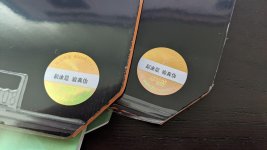Pleiades, it seems to me that this is a much more interesting point than it may initially seem.
It is amazing to me that rubbers that are so different can have the same ITTF identifying number. The rules ITTF has for racket coverings and their approval are quite specific and are found here:
http://www.old.ittf.com/ittf_equipment/Technical_Leaflets/T4_Racket_Coverings.pdf
According to the that document, the procedure is that DHS informs ITTF that they are coming out with a rubber, they are given an ID code for that rubber (the one we will eventually see on the rubber) and then submits samples for testing along with a testing fee and also an authorization fee (the later they have to pay every year). They are not supposed to sell or distribute any rubber before the tests are finished.
Now, here is the thing: It also says that
"The ITTF authorisation applies to a racket covering as originally submitted and tested; its subsequent alteration, by a supplier, a player or anyone else, is not permitted". [emphasis added]
Now if the "provincial" and "national" and "super-duper secret Ma Long versions" are all different from each other and from the "commercial" versions that they sell to all the rest of us, say, at TT11, than how can all of those various versions have the same ITTF ID number? Only one of them could have been approved by ITTF? Which one? If it was something other than the kind Ma Long or FZD uses, or if those players are each getting their own custom versions, how can that be legal according to ITTF? Since those would not be the same as the ones originally supplied for testing?
It not the ITTF allowing DHS to collude with the CNT to provide them with an unfair advantage?











